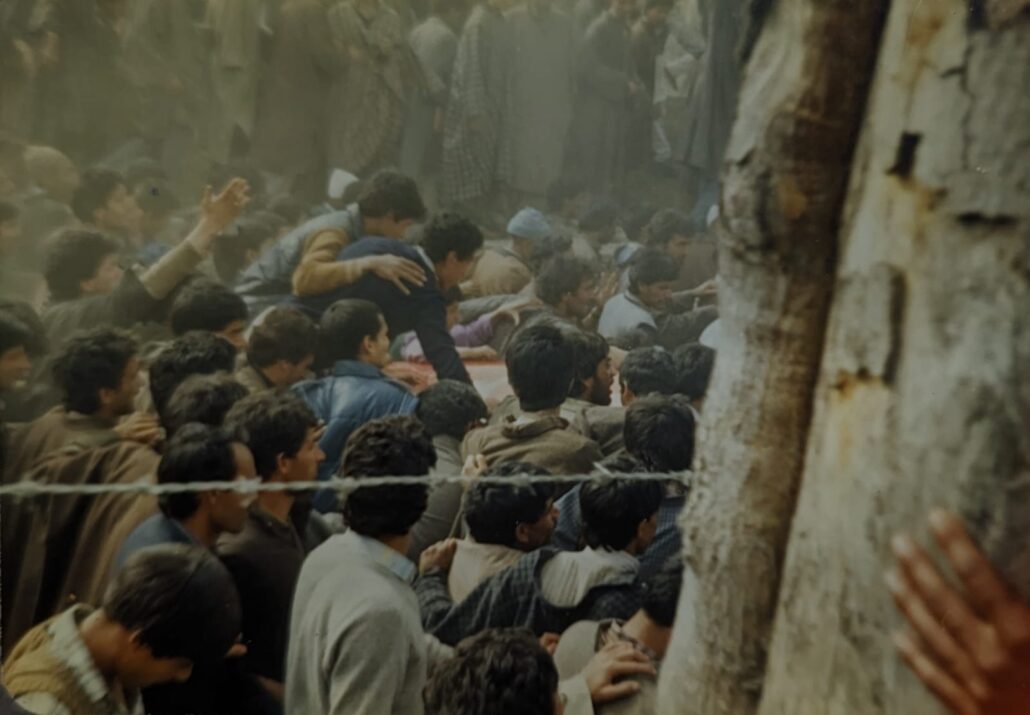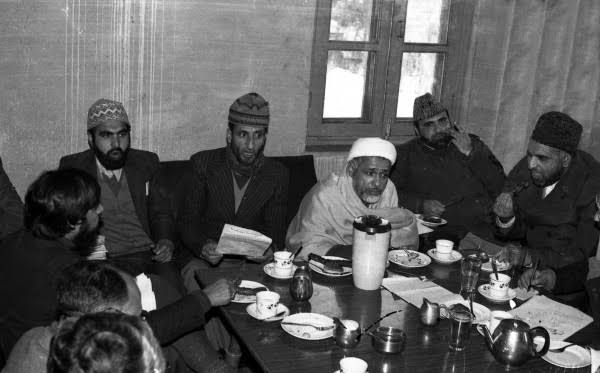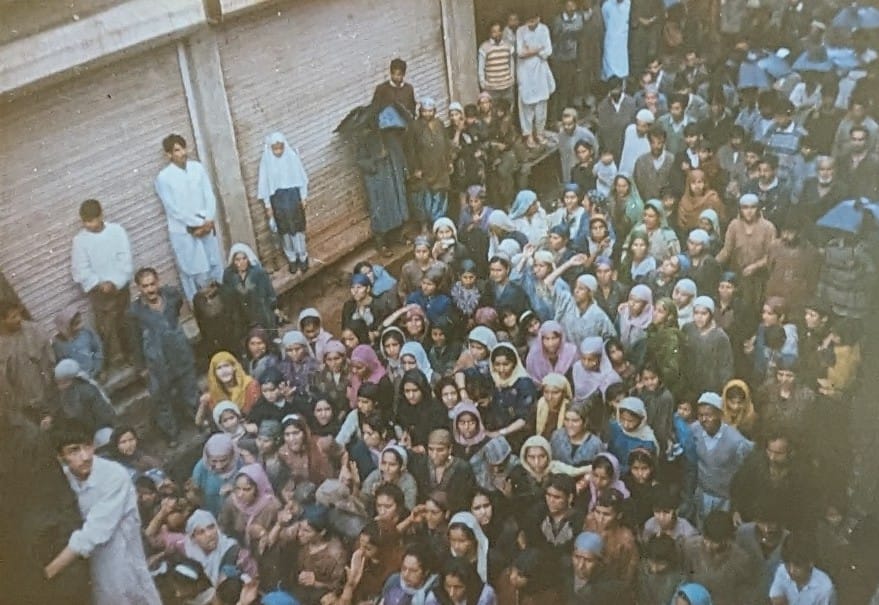
Qazi Shibli
“We could see green flags atop the willows, chinars and the electric polls; women and men rallying with green flags, singing folktales for their brave candidates, ‘Islam will win’ was the word of every tongue,” Reyaz Ahmed, a resident of Shangus, who campaigned for Muslim United Front in the year 1987 remembers.
The year 1987 marked a watershed in Kashmiri politics. The Muslim United Front (MUF), a broader coalition of socio-religious groups within the Kashmir valley joined hands to fight the National Conference-Congress alliance. It enjoyed huge public support within Kashmir. However, it was defeated by dubious means.
Those who supported the MUF were convinced that the establishment of a MUF government would achieve the wipe-out of corruption, nepotism, and misgovernance and would improve the financial condition of Muslims. Supporters were all convinced that those bureaucrats, politicians, and agencies that had used their official positions to victimize a common Kashmiri, would be censured.
In various constituencies, where elections were manipulated, polling agents of the Muslim United Front were detained and publicly beaten, not by the police alone but also by the National Conference candidates. Prominent candidates and leaders of the Muslim United Front and their supporters were detained and tortured and many were booked under the Public Safety Act.
It was this episode in the history of Kashmir, which led to the birth of militancy. Five young men who were arrested after the poll rigging later started armed militancy in Kashmir. Mohammad Yousuf Shah who contested elections on the Amira Kadal constituency, left Kashmir to escape torture and today he leads the United Jihad Council- an umbrella of militant outfits in Kashmir.
The Prelude
On the first February of 1986, orders were passed by the District and Sessional courts to open the gates of Babri Masjid for Hindu worshippers during the Rajiv Gandhi-led Congress government. This political move was met by resistance across the Indian nation-state by the minority Muslim citizens. The state of Jammu and Kashmir also saw series of protest demonstrations by the Muslim community creating a violent backlash, which at certain regions led to riots.
In February 1986, Kashmir also witnessed protests at Islamabad (Anantnag) under the leadership of Dr. Qazi Nisar- a member of the Babri Masjid Action Committee against unlocking the gates of Babri Masjid. A few days after the protest, the news of targeted demolition of households and temples belonging to the minority Hindu community came up which soon took the face of riots, spreading across nearby regions. Experts believe that these riots had more political overtones than religious ones.
According to Mir Muntazir Gul, who worked under Dr. Ghulam Qadir Wani and was a close associate of Dr. Wani, “A rift started between the DG M.N. Khajuria and SSP Nayeem Mohammad Abdullah in the handling of the situation. DG Khajuria emphasized the use of bullets to control the riot situation but the police officials SSP Mir Mohammed Abdullah and DC Abdul Waheed refused, leading to their suspension.
In the first week of February, the news reached Dr. Qazi Nisar, a flamboyant, young Ph.D. scholar from the heart of the Anantnag town. Dr. Nisar started a demonstration at Lal Chowk, Anantnag against the suspension of the DC and SSP Anantnag who had refused to fire upon the protesters.
In the next few weeks, nearly seven to eight hundred men were arrested for involvement in the communal riots, although later, most of them were released. Three academics namely Prof. Abdul Gani Bhat, Abdul Rahim and Shariefuddin on 27th February 1986, who later formed MEF (Muslim Employees Front) were suspended for “constituting a threat to the security of the state”.
In Anantnag, a few days later, Qazi Nisar was stone pelted by the residents of a locality belonging to the Pandit community showcasing their disapproval of the protests led by Nisar, injuring him. The stone-pelting incident of Qazi Nisar took notice of several other Muslim organizations which became the prelude to the creation of the Muslim United Front.
Ghulam Rasool Qadri, a local cleric of a religious group, Jamiat e Ahli Hadith led a protest against the stone pelting on Dr. Nisar. Within days, a forum was set up for organizing the majority population against political, economic, and social suppression. The movement, also known as “the second golden period of Islam after the arrival of Shah e Hamdan in Kashmir,” drew massive support in Kashmir which saw the transgression of boundaries of thought and sects.
By March 1986, prayers were being collaborated by various schools of thought, and this was happening in Kashmir for the first time inarguably. Within no time, Moulana Abbas Ansari got in touch with Dr Nisar and initiated talks and then a series of negotiations with him through Ghulam Rasool Wani.
Abbas Ansari in his autobiography, ‘Khar e Gulistan’ speaks of various meetings he held with Dr. Qazi Nisar in Anantnag. On the 10th day of April 1986, Mr. Ansari called a meeting with Dr. Nisar at his residence in Srinagar to officially “introduce” Qazi Nisar, who had remained “confined to Anantnag”.

He says that Dr. Nisar had already become a face of the struggle post-formation of Ummat-e-Islami in 1986 against mass suspension of Muslim employees and public animal slaughter rejecting the order by then-governor Jagmohan, of the ban on meat consumption on Hindu festival Janamashtami.
The protests in Anantnag, led by Dr. Nisar led to the release of the majority of people arrested under the communal riots act while the remaining two were booked under the Public Safety Act. Mohammed Ramzan Padder and one more resident of Quimoh Kulgam were booked under the Public Safety Act. Ramzan, a Government employee, who was a resident of the Sallar area of Pahalgam belt in Anantnag was accused of offering Adhaan near a temple.
The rise in communal tension became the said reason for the expulsion of the Gull Shah government and the power shifted into the hands of Governor Jagmohan on the 12th of March, 86.
During Jagmohan’s first phase of holding office, the Muslim population found themselves to be isolated from job opportunities. The mass suspension of Muslim government employees and the deliberate insertion of employees belonging to mainland India furthered the sense of alienation.
Jagmohan also terminated nine employees associated with MEF for being communal. According to Ansari, Jagmohan was a member of the BJP and shared ideological views with other Hindu Right Wing organizations like Shiv Sena.
MUF Takes a Shape
The historic meeting of 10 April 1986 led by Qazi Nisar at Mr. Ansari’s house, attended by representatives of cross-sections of the society, including the members of the Muslim Employees Forum joined hands to improve the socio-political situation in the valley. In this meeting representatives of seventeen organizations participated.
In the consecutive days, various religious, political groups and eminent personalities of Kashmir made their entry to this unnamed coalition. On 21st day of April 1986, during a meeting held in the Khanyar area of Srinagar, various names were proposed, but Professor Bhat, Ghulam Qadir Wani proposed the name- Muslim United Front which was later adopted.
Meanwhile, Jammu Kashmir was witnessing a massive political tumult and the youth were majorly disillusioned with the traditional politics, the rigging in elections, nepotism and corruption.
When the international press challenged the fairness of elections in Kashmir, the then Indian Prime Minister Jawahar Lal Nehru wrote to Bakhshi Gulam Mohammad after the 1962 polls, advising him to lose a few seats in future, so that the image of India is not tarnished. In the subsequent elections of 1967, 1972 and 1983 (leaving aside the elections of 1977), the sabotage of representative democracy was considered a normal practice- Mehraj Hajini’s, ‘Democracy of Denial in Kashmir.’
Mir Muntazir Gul (58), a prominent academic from the Aishmuqam area of Anantnag says, “It was a massive public outpour against the discriminative policies of the continuous regimes in Kashmir. These dejected people saw their representation in Muslim United Front.” Mr. Muntazir says that supporters of the Front believed that MUF would succeed in the betterment of the valley by eradication of corruption, unemployment and poverty.
Muslim United Front was not merely an outburst, it was born in the denial of political and economic opportunities to a common Kashmiri Muslim, who had seen years of exploitation by the Hindu groups.

The first Convener and Constitution of MUF
On July 13, 1986, Muslim United Front met at the house of Professor Bhat and Jamaat too entered the MUF. In this meeting, Moulana Abbas Ansari was appointed as the first convener of the Muslim United Front, Dr Ghulam Qadir Wani as the General Secretary and Professor Bhat as the Spokesman. On 2nd September of the same year, a constitution was adopted by the forum, along with the formation of the first executive body with Moulana Abbas Ansari as convener, Prof. Bhat as Spokesperson, Qadir Wani as General Secretary.
The constitution of the Muslim United Front drafted by Professor Bhat, Dr Nisar and Dr Wani which was adopted on 06 September 1986, focused on the upliftment of the Muslim population, especially in the education sector with technical knowledge, to empower Muslim students with employment and economic opportunities and to fight for their rights.
Meanwhile, the charges of misgovernance, lack of basic facilities was growing in Kashmir. By 1986, Centre received complaints about the “high-handedness” of Governor Jagmohan’s rule. “Jagmohan’s precipitous actions were allegedly ‘destroying’ the local economy and causing much distress to the common people,” (India Today- 1986 November.)
Days before, when Dr Nisar was on his way to Srinagar to announce the constitution during a press meet, he was arrested along with Ghulam Rasool Qadri. Nisar was booked under Public Safety Act which started a series of protests in Kashmir.
On 10 September, during a match between India and Australia, Muslim United Front issued its first shutdown call against the arrests of Qazi Nisar and Dr Wani during separate incidents. South Kashmir shut for several weeks to protest against the detentions.
Watch the video:
On the 13th day of September, Sunnis and Shias participated in the Muharram procession together. The arrest of Dr Nisar and others sparked widespread outrage in colleges and universities across Kashmir. Governor Jagmohan, on 21 September 1986 fearing protests shut down educational institutes across the Kashmir valley.
The Muslim United Front put forward seven demands including the release of Dr. Nisar and all political prisoners, the reappointment of terminated employees, equal rights in academic and job opportunities for Muslims among others.
MUF members were released on 6th November, after the Rajiv-Farooq accord, post which the forum started its official operations. During the jail time, Muntazir recalls, “Muslim United Front was created more inside the jails than on the ground, inside torture cells more than in public rallies.” When Dr. Nisar came out, he was welcomed by thousands of people in Qazigund, who later foot marched to Anantnag town. Here, several members of the Muslim United Front had reached the township, he invited them to the podium to address the people.

The Organizational Structure and the Election Debate
Although Kashmir saw some protests on the removal of Abdullah by Indira Gandhi-led government, his reinstallation by Rajiv Gandhi post assassination of Mrs. Gandhi raised questions. An interim coalition government was formed by National Conference and Congress. Tavleen Singh writes, “Overnight, Farooq was transformed from a hero to traitor in Kashmiri minds.”
The space created by the fall of Farooq’s image was occupied by MUF.
Jamaat-e-Islami became a member of MUF after the popularity attained by the organization among the masses and the creation of a political stir, as remarked by the first convener of the Muslim United Front and several key faces. Syed Ali Shah Geelani accepted membership of MUF in Jail by writing a letter to Ghulam Qadir Wani, general secretary of MUF. After the (immediate) release of Geelani, the question of MUF’s political contestation in upcoming elections started coming into frame. The organization separated into two, for and against the contestation. Geelani, a prominent member of Jamaat and the party itself were in favor of participation.
The key member groups included the Islamic Students League, Jamiat e Ahle Hadees, itehad ul Muslimeen, Ummat e Islami, Jamaat e Islami, Islamic Study Circle, Muslim Educational Trust, Jamiat e Tulba, Muslim Welfare Society, Majlis e Tahafuz ul Islam, Muslim Employees Front, Tableegh ul Islam, Hussaini Medical Trust, World Islamic Mission and Shia Coordination Committee.
Jamaat e Islami had been participating in elections since the seventies. In an interview, Prof. Gani Bhat says that the reconciliation of the two sides became difficult and had to be taken forward strategically which also educates as well as involves the masses.
To be Continued
Qazi Shibli is an editor with The Kashmiriyat. His works have appeared in various local and international publications, A Journalism Graduate from Bangalore University, Shibli also has published documentaries.




